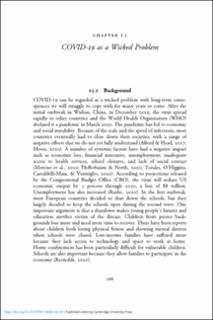| dc.contributor.author | Baltzersen, Rolf K. | |
| dc.date.accessioned | 2022-09-25T23:42:28Z | |
| dc.date.available | 2022-09-25T23:42:28Z | |
| dc.date.issued | 2022 | |
| dc.identifier.uri | https://hdl.handle.net/11250/3021119 | |
| dc.description | Chapter 13 in Cultural-historical perspectives on collective intelligence
In the era of digital communication, collective problem solving is increasingly important. Large groups can now resolve issues together in completely different ways, which has transformed the arts, sciences, business, education, technology, and medicine. Collective intelligence is something we share with animals and is different from machine learning and artificial intelligence. To design and utilize human collective intelligence, we must understand how its problem-solving mechanisms work. From democracy in ancient Athens, through the invention of the printing press, to COVID-19, this book analyzes how humans developed the ability to find solutions together. This wide-ranging, thought-provoking book is a game-changer for those working strategically with collective problem solving within organizations and using a variety of innovative methods. It sheds light on how humans work effectively alongside machines to confront challenges that are more urgent than what humanity has faced before. This title is also available as Open Access on Cambridge Core. | en_US |
| dc.description.abstract | Chapter 13 describe COVID-19 as a wicked problem and show how different CI-mechanisms have been used to cope with the pandemic. The first CI-mechanism is the transparent information flows during the pandemic. Knowledge is being shared at a rapid pace in the global online setting. Most of the big news sites provide citizens with updated statistics on the spread of the virus. Another example is the governmental “test and trace”-strategy that aims to maximize information about the spread of the virus at all times. A second CI-mechanism is citizen responsibility. Citizens in all countries have faced the challenge of complying with behavioral rules enforced by the government. | en_US |
| dc.language.iso | eng | en_US |
| dc.publisher | Cambridge University Press | en_US |
| dc.rights | Attribution-NonCommercial-NoDerivatives 4.0 Internasjonal | * |
| dc.rights.uri | http://creativecommons.org/licenses/by-nc-nd/4.0/deed.no | * |
| dc.subject | The test and trace strategy | en_US |
| dc.subject | Collective learning | en_US |
| dc.subject | South Korea | en_US |
| dc.subject | Effective communication | en_US |
| dc.subject | Transparent information | en_US |
| dc.subject | Rule compliance | en_US |
| dc.subject | Citizen responsibility | en_US |
| dc.subject | New Zealand | en_US |
| dc.title | COVID-19 as a Wicked Problem | en_US |
| dc.type | Chapter | en_US |
| dc.description.version | publishedVersion | en_US |
| dc.rights.holder | Rolf K. Baltzersen | en_US |
| dc.source.pagenumber | pp 366-380 | en_US |
| dc.identifier.doi | 10.1017/9781108981361.013 | |

